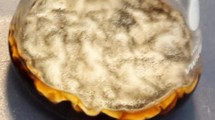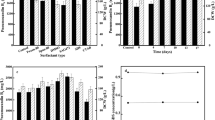Abstract
Aspergillus niger spores were used as catalyst in the bioconversion of glucose to gluconic acid. Spores produced by solid-state fermentation were treated with 15 different terpenes including monoterpenes and monoterpenoids to permeabilize and inhibit spore germination. It was found that spore membrane permeability is significantly increased by treatment with terpenoids when compared to monoterpenes. Best results were obtained with citral and isonovalal. Studies were carried out to optimize spores concentration (107–1010 spores/mL), terpene concentrations in the bioconversion medium and time of exposure (1–18 h) needed for permeabilization of spores. Fed-batch production of gluconate was done in a bioreactor with the best conditions [109 spores/mL of freeze-thawed spores treated with citral (3% v/v) for 5 h] followed by sequential additions of glucose powder and pH-regulated with a solution containing 2 mol/L of either NaOH or KOH. Bioconversion performance of the spore enzyme was compared with the commercial glucose oxidase at 50, 60, and 70 °C. Results showed that the spore enzyme was comparatively stable at 60 °C. It was also found that the spores could be reutilized for more than 14 cycles with almost similar reaction rate. Similar biocatalytic activity was rendered by spores even after its storage of 1 year at −20 °C. This study provided an experimental evidence of the significant catalytic role played by A. niger spore in bioconversion of glucose to gluconic acid with high yield and stability, giving protection to glucose oxidase.







Similar content being viewed by others
References
Murata, K. (1993). Use of microbial spores as a biocatalyst. Critical Reviews in Biotechnology, 13, 173–193.
Ramachandran, S., Pandey, A., & Larroche, C. (2007). Production of spores in SSF. In A. Pandey, C. Larroche, & C. R. Soccol (Eds.), Current developments in solid-state fermentation (pp. 193–213). New Delhi: Asiatech Inc.
Shigematsu, T., Matsutani, K., Fukuda, Y., Kimura, A., & Murata, K. (1992). Enzymes and germination of spores of a yeast Saccharomyces cerevisiae. Journal of Fermentation and Bioengineering, 75, 187.
Larroche, C., & Gros, J. B. (1997). Special transformation processes using fungal spores and immobilised cells. Advances in Biochemical Engineering, Biotechnology, 55, 179–220.
Ramachandran, S., Fontanille, P., Pandey, A., & Larroche, C. (2006). Gluconic acid: properties, applications and microbial production. Food Technology and Biotechnology, 44, 185–195.
Moksia, J., Larroche, C., & Gros, J. B. (1996). Gluconate production by spores of Aspergillus niger. Biotechnology Letters, 18, 1025–1030.
Ramachandran, S., Fontanille, P., Pandey, A., & Larroche, C. (2007). Spores of Aspergillus niger as reservoir of glucose oxidase synthesized during solid-state fermentation and their use as catalyst in gluconic acid production. Letters in Applied Microbiology, 44, 155–160.
Ramachandran, S., Fontanille, P., Pandey, A., Larroche, C. (2008). Stability of glucose oxidase activity of A. niger spores produced by solid-state fermentation and its role as biocatalyst in bioconversion reaction. Food Technology and Biotechnology.
Ramachandran, S., Fontanille, P., Pandey, A., Larroche, C. (2008) Permeabilization and inhibition of the germination of spores of Aspergillus niger for gluconic acid production from glucose. Bioresource Technol. 2007, DOI 10.1016/j.biortech.2007.06.055.
Pandey, A., Soccol, C. R., & Mitchell, D. (2000). New developments in solid-state fermentation: I-Bioprocess and products. Process Biochemistry, 35, 1153–1169.
Larroche, C., & Gros, J. B. (1989). Strategies for spore production by Penicillium roquefortii using solid state fermentation techniques. Process Biochemistry, 24, 97–103.
Sumner, J. B. (1925). A more specific reagent for the determination of sugar in urine. Journal of Biological Chemistry, 65, 393–395.
Moellering, H., & Bergmeyer, H. U. (1988). D-gluconate (D-glucono delta lactone) and D-gluconate-6-phosphate. In H. U. Bergmeyer (Ed.) Methods of enzymatic analysis, vol. 4 (pp. 220–227). Cambridge, UK: VCH.
Stammati, A., Bonsi, P., Zucco, F., Moezelaar, R., Alakomi, H. L., & von Wright, A. (1999). Toxicity of selected plant volatiles in microbial and mammalian short-term assays. Food and Chemical Toxicology, 37, 813–823.
Sikkema, J., de Bont, J. A., & Poolman, B. (1995). Mechanisms of membrane toxicity of hydrocarbons. Microbiological Reviews, 59, 201–222.
Pattnaik, S., Subramanyam, V. R., Bajpai, M., & Kole, C. R. (1997). Antibacterial and antifungal activity of aromatic constituents of essential oils. Canadian Journal of Microbiology, 27, 39–46.
Scora, K. M., & Scora, R. W. (1998). Effect of volatiles on mycelium growth of Penicillium digitatum, P. italicum and P. ulaiense. Journal of Basic Microbiology, 38, 404–413.
Wolken, W. A. M., Tramper, J., & Van der Werf, M. J. (2002). Toxicity of terpenes to spores and mycelium of Penicillium digitatum. Biotechnology and Bioengineering, 80, 686–690.
Munoz, G. A., Agosin, E., Cotoras, M., San Martin, R., & Volpe, D. (1995). Comparison of aerial and submerged spore properties for Trichoderma harzianum. FEMS Microbiology Letters, 125, 63–70.
Gouda, M. D., Singh, S. A., Rao, A. G. A., Thakur, M. S., & Karanth, N. G. (2003). Thermal inactivation of glucose oxidase—mechanism and stabilisation using additives. Journal of Biological Chemistry, 278, 24324–24333.
Kalisz, H. M., Hecht, H. J., Schomburg, D., & Schmid, R. D. (1990). Crystallization and preliminary X-ray diffraction studies of a deglycosylated glucose oxidase from Aspergillus niger. Journal of Molecular Biology, 213, 207–209.
Nakamura, S., Hayashi, S., & Koga, K. (1976). Effect of periodate oxidation on the structure and properties of glucose oxidase. Biochimica et Biophysica Acta, 443, 294–308.
Wolken, W. A. M., Tramper, J., & Van der Werf, M. J. (2003). What can spores do for us? Trends in Biotechnology, 21, 338–345.
Author information
Authors and Affiliations
Corresponding author
Rights and permissions
About this article
Cite this article
Ramachandran, S., Fontanille, P., Pandey, A. et al. Fed-batch Production of Gluconic Acid by Terpene-treated Aspergillus niger Spores. Appl Biochem Biotechnol 151, 413–423 (2008). https://doi.org/10.1007/s12010-008-8209-0
Received:
Accepted:
Published:
Issue Date:
DOI: https://doi.org/10.1007/s12010-008-8209-0




